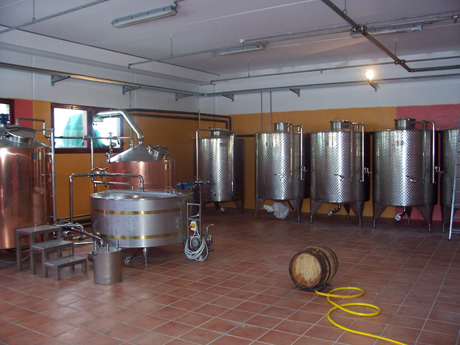A cackling rooster call pierced the silence, followed by the sound of quiet laughter. We stood in a courtyard ringed by oppressively institutional gray buildings, and I swiveled my head nervously as a stiff breeze blew through Saluzzo. The giggly presence of two dozen young students had attracted some attention from the residents of this casa di reclusione. In less euphemistic, non-Italian terms, that would be a prison.
“Welcome to the Saluzzo prison,” said our guide, Andrea. “I apologize for the ID screening and metal detector. As you can see, it is very difficult to visit here, but visitors are very important because they provide a window to the outside world. In return, we will now drink.”
Moving along the sidewalk, we turned a corner and were confronted with the intense smell of warm bread. We had arrived here to see the Pausa Cafe brewery project, a non-profit cooperative that works with prisons in Torino and Saluzzo in beer brewing and coffee cafe programs. The mission is to help rehabilitate prisoners and give them productive skills that they can use once no longer behind bars. The cooperative began in 2004, and has successfully employed about 30 prisoners over the last few years. None have been reincarcerated once released from prison. Currently, the Saluzzo brewery employs 3 prisoners, along with 2 non-inmates, and inmate employees are paid 900 euros per month. The brewery produces around 50.000 liters of beer annually, which is sold in Coop grocery chains, gourmet groceries, CSAs, and exported to Norway and the US.
All this would be a noble cause in and of itself, but the icing on the cake is that Pausa produces very, very good artisanal beers. “Here, we are in another world, separate like the outside, like a monastery. And as the monks brewed beer, we too brew beer.” Brewmaster Andrea has spent a significant amount of time living and studying beer brewing in Belgium, and the knowledge has obviously influenced his work in Italy.
We were able to try the DUIeMES, a light Belgian saison, gently spiced with saffron and pepper. It is made in the style of traditional low-alcohol European methods popular until the 1950s, and contains only 2.5% alcohol (hence the name). The P.I.L.S. was also quite tasty, a Bohemian style Pilsner made with Saaz hops, giving it a nice herbal aroma. It is aged for 10 weeks in oak casks.
The next beer we tried was unlike anything I have ever tasted before, and we were warned beforehand that it might be an acquired taste. Dubbed “Martina,” the beer smelled like banana and grapes, tasted like grapefruit or a tart white wine, and had almost no carbonation. Noses wrinkled and some students muttered in dismay. This was a Belgian gueuze, a very traditional Trappist style that is made by blending young Lambics into a new beer, which then undergoes a second fermentation. The second version we tried included the addition of fruit to lower the acidity, which added some pear and cherry flavors, but still did not make it entirely palatable in my opinion. Finally, the Tosta, a 12.5% barley wine made with cacao from Puerto Rico. This was universally loved by everyone, a thick, syrupy concoction that we happily drank as we trundled back to our bus.
Pausa plans to expand their prison rehabilitation work to other locations, possibly with a bakery or cheese and dairy projects. Given the high quality and unique nature of their beers, I am eager to see what else they can do.
Note: we were stripped of all cell phones, cameras and other recording devices upon arrival, so the photo above is not mine. I am not sure how that person was able to take it…
